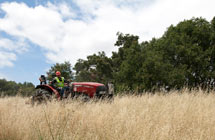
Handy Links
SLAC News Center
SLAC Today
- Subscribe
- Archives: Feb 2006-May 20, 2011
- Archives: May 23, 2011 and later
- Submit Feedback or Story Ideas
- About SLAC Today
SLAC News
Lab News
- Interactions
- Lightsources.org
- ILC NewsLine
- Int'l Science Grid This Week
- Fermilab Today
- Berkeley Lab News
- @brookhaven TODAY
- DOE Pulse
- CERN Courier
- DESY inForm
- US / LHC
SLAC Links
- Emergency
- Safety
- Policy Repository
- Site Entry Form

- Site Maps
- M & O Review
- Computing Status & Calendar
- SLAC Colloquium
- SLACspeak
- SLACspace
- SLAC Logo
- Café Menu
- Flea Market
- Web E-mail
- Marguerite Shuttle
- Discount Commuter Passes
-
Award Reporting Form
- SPIRES
- SciDoc
- Activity Groups
- Library
Stanford
Around the Bay
Preparing for Wildland Fire Season
Recent rains might give a different impression, but fire season is coming soon. The area around SLAC averages of about 16 inches of annual rainfall. This year, though, rainfall has surpassed 20 inches, resulting in a luxurious growth of grass and brush. Ironically, this extra rain and lush plant life can actually worsen fire risk. Once dried, this vegetation can present a severe fire threat.
SLAC guards against the threat of wildfire by having landscapers provide extensive weed cutting around heavily traveled areas, such as near roads and buildings, and by "disking" strips adjacent to SLAC boundaries. Disking uses a tractor to plow grass and brush into the ground, creating a bare strip that fire has difficulty crossing. These barriers are effective in preventing small fires from traveling onto or off of SLAC property. These vegetation control activities are conducted by SLAC Facilities Contractors in May and June, before the grass and brush get too dry to cut safely.
SLAC typically experiences one or two wildfire threats each year. Due to prevention and quick action, these fires are almost always contained to substantially less than one acre. Last year, cutting and disking activities helped to control two fires. One fire started adjacent to Highway 280 and was prevented from moving onto SLAC property because it was unable to cross the plowed strip next to the site fence. The other fire was contained to about 1/3 acre by grass cutting and wetting activities around the fire.
In the event of a wildfire threat in the SLAC area, the SLAC Information Hotline, 1-877-447-SLAC (7522), will provide information on evacuation plans. News will also be provided directly to SLAC employees who have registered their phone or e-mail addresses with the SLAC 911 alert notification system.
SLAC employees and visitors can help keep SLAC safe from wildfire by paying close attention to potential ignition sources during the summer months. Smoking should be restricted solely to designated smoking areas. Avoid driving over or backing vehicles into dry grass or brush. Obtain a hot work permit before using any open flame sources in outdoor areas, and use alternative means that don’t involve arcing, flaming or sparking whenever possible. When barbequing, obtain hot work permits and avoid lighting up near wooden decks, combustible storage or grassy areas. Have a fire extinguisher on hand.
SLAC will post signage and issue notifications in the event of rare "red flag" days. Such days typically occur in the early fall and involve low humidity, high temperatures and strong, dry breezes. Under these conditions, fires can "blow up" and quickly grow out of control before firefighters can arrive to battle the blaze, so the lab must be extra vigilant at these times.
The fire season is beginning late this year due to the late rains, and will last until the first couple of good rains in the late fall. During fire season, if you spot smoke or other worrying signs, call 911 immediately, followed by SLAC Security (x5555). If you smell or see smoke coming from well off-site and it does not appear to pose an immediate threat to SLAC, please alert SLAC Security.
—Ralph Kerwin and Lance Lougee
SLAC Today, June 1, 2010
